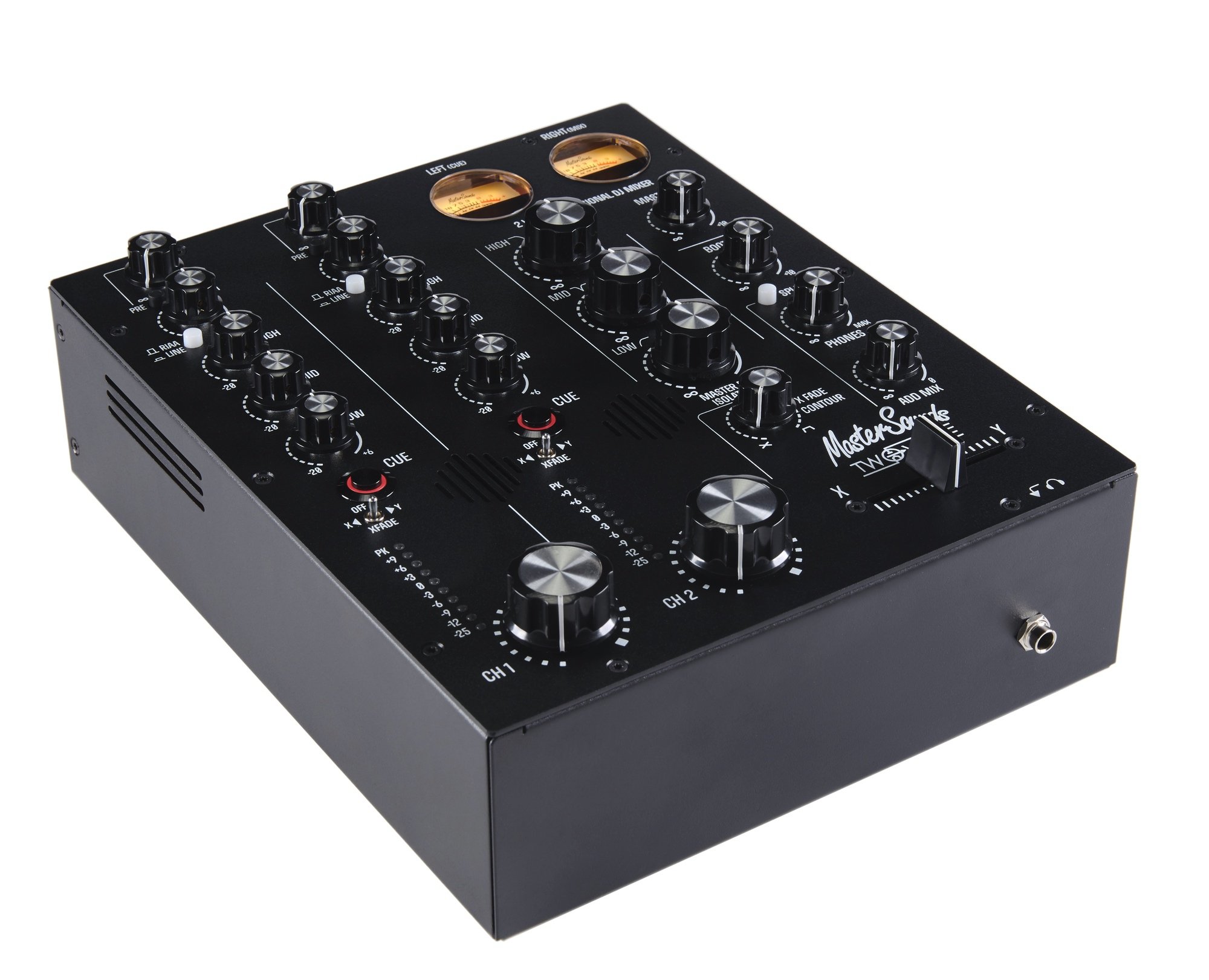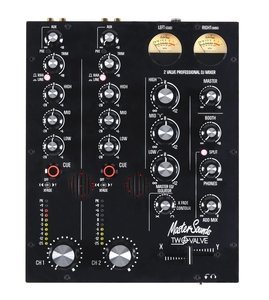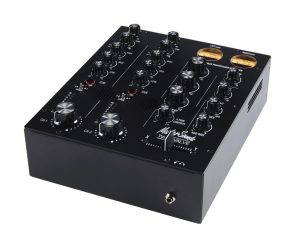Following up on their lush Radius 4V offering, MasterSounds has taken a chainsaw to it, and now offer the Radius Two Valve, a compact 2 channel rotary mixer that delivers more of Andy Rigby Jones’ Union Audio genius, but in a smaller chassis.
Read these words:
MASTERSOUNDS LAUNCHES RADIUS TWO VALVE COMPACT DJ MIXER
Building on the success of its flagship Radius 4V DJ mixer, boutique mixer brand, MasterSounds, has added the compact Radius TWO VALVE to its range. The new 2 channel DJ mixer is manufactured using the highest quality components, and comprises a similar feature set as its award-winning 4 channel sibling, in a smaller footprint.
At the heart of TWO VALVE and its unique sound quality are two dual triode valves, which form part of the input buffer stage to the VCAs.
“The valves’ high input impedance minimises loading on the preceding stages but provides low output impedance to drive the VCAs, whilst natural compression smooths and warms harsh transients. Careful circuit design around the valves minimises noise and distortion,” explains leading DJ mixer designer, Andy Rigby-Jones, from MasterSounds’ technology partner, Union Audio.
TWO VALVE comprises 2 fully-featured channel strips with Aux send (switchable pre or post fader), input level trim, illuminated input select switch, a super smooth 3-band asymmetric EQ, large illuminated Cue switch and high quality ALPS rotary faders.
To the right of the channel strip features a 3-band Master EQ/Isolator, Master and Booth level controls, and headphone monitor with split and Cue/add mix control. Below the master section is a high-quality Penny & Giles crossfader, with contour control to adjust the curve from smooth mix to fast cut.
Two 36mm illuminated analogue VU meters provide accurate signal level monitoring of the mix buss, which automatically switch to monitoring the Cue level when a channel Cue is activated. If the signal level is excessive, the VU meter illumination will change from warm white to bright red.
A new split composite/passive RIAA stage featuring Vishay 2% Polypropylene capacitors, close tolerance thin film resistors and JFET pre-amplifiers provide outstanding fidelity from the turntable inputs. All circuit coupling is through bypassed Panasonic electrolytics to preserve this fidelity throughout the entire signal chain. The icing on the cake is a pair of MUSES operational amplifiers providing world class summing for the fully balanced main mix buss.
Finally, MasterSounds mixers are hand built at Union Audio in Cornwall, UK, ensuring the finest build quality and attention to detail.
“TWO VALVE has been designed for clubs and DJs requiring a conventional DJ toolkit with ‘no compromise’ audio fidelity. It is the ideal companion for DJ purists who only require 2 audio channels in a premium package. The open, dynamic and transparent sound stage, portable size for carrying between venues, and intuitive feature set gives users an optimal DJ experience, be it at home or in the club,” concludes MasterSounds founder, Ryan Shaw.
Priced at £1495
Available to order immediately via www.mastersounds.co.uk or www.phonicarecords.com
I LIKE THIS
It has long been my contention that the DJ industry should consider building some simpler mixers that will last longer, you know — like a 1200. Obviously they would be more expensive but they could be your mixer for life. And this is so close to being something like that for me.
You see, I want the best of diverse worlds — of rotary mixers and of scratch mixers – and unfortunately these are pretty much polar opposites. But the Radius Two Valve does its best to bridge the gap.
Despite the constant stream of 4 channel goodies passing through my hands, I’ve only ever needed 2 channels. The other spare channels would sit doing nothing other than taking up space and emptying my wallet.
BUT…
So for me, it’s nice to see all this rotary goodness blended with a crossfader complete with a curve control and reverse courtesy of the XY Xfade switches. But for me, there is quite a large logistical issue here, and that’s the proximity of the crossfader to the channel rotaries. By my calculations it’s just 30mm between the prominent channel rotary and the left hand edge of the fader slot, which pretty much makes it a non-starter for me. I’m at somewhat of a loss why you would add a fader curve, reverse capability, and then leave no room for scratching.
Please ignore my over-picky fussiness. I’m sure a more scratch oriented DJ would pick a far more scratch friendly mixer, and the target audience is less likely to touch the fader let alone care about the space around it. I’m beginning to think that the Rane Empath Rotary may well be the mixer I’m looking for.
SUMMING UP
But there’s no denying that the Radius Two Valve is going to please a huge number of people. The combination of MasterSounds and Union Audio is one that makes the heart miss a beat. Their stuff is stellar, and from my brief experience of it, made for life. And it’ll be a beautiful thing to see one sat next to the Mastersounds FX unit too.
As all good gear should be in these impatient need it today times, the MasterSounds Two Valve is available right away, and will cost £1495. Yes it is an investment, but it’ll be an heirloom, and will also keep its value should you decide that you do need more than two channels after all.
GALLERY










I get the design choice from a manufacturing stand point.
But I think it looks like what it really is: 2 channels chopped off a 4 channel mixer.
A mirrored layout with the master / iso / headphone section and the crossfader in the middle would not only have been more eye-pleasing, but probably more ergonomic and therefore more successful.
I like the high quality boutique nature of it. I do quite fancy one. My tiny hands might just get away with scratching next to those rotaries.
Does the “add mix” control send the master output to the headphones? So you can have traditional master cue in stereo?
Re “Add mix”: yes it does.
Great disco mixer. One thing I miss is dvs loops per channel to add a soundcard.
And a master/booth mono sum button, at least on the back.
I don’t get this mixer, I “get” the principle but this is two channel, which in today’s scene is pretty much the scratch/turntablist DJs and as you also state, there’s no room to scratch, two giant rotaries get in the way.
I think there are many non-scratching DJ’s (like me) that only need 2 channels. Having a crossfader on a rotary for the occasional need to cut is best of both worlds imo.
My only issue is id love to have the standard 2 channel Mastersounds with a crossfader for cutting, hi pass filter>EQ for me all day.
Why on earth is this mixer powered by a wall wart if its built to top spec? The wall wart and the awkwrd xfader = no thx
Do your research before commenting. Internal power supplies contribute a massive amount to the noise floor of any mixer therefore most high end mixers use an external power supply. Master sounds give you the option to buy an upgraded external power supply to reduce noise even further.
What’s “awkwrd” about a high quality Penny & Giles CF? And what is wrong with having an external PSU?
If the PSU is attached to the prongs then it covers up over other outlets.
I just noticed those little XY Crossfader switches on each channel, that will be a great addition for transforming the old school way.
So now im thinking should i buy this or take another holiday? Let destiny decide, people are waiting for me though.
I had the same consideration. Then I thought, that vacation ends after 2 weeks, while this mixer will be there for the rest of my life.. So I chose the mixer. ;)
@marksettle The distance between the right channel rotary and the left side of the cross fader is actually 35 mm. And it doesn’t feel crammed to me, but then again I’m not a big handed scratching turntablist.. :) I agree with the article that this is a mixer made for life. It’s an incredible piece of kit and it’s feature set, sound & build quality will appeal to many.
I have relatively small hands and can still catch them on countersunk screws. So I’ll absolutely catch them on a large rotary control.
Maybe you should try the mixer.. I think you’ll like it.
Besides the position issue of the CF, it’s also dodgy to add an average CF on the signal path of such a delicate mixer.
Bad idea.
How do you know that it’s an “average” crossfader?
My assumption is that because it’s not specified by name like Innofader, Pro X Fade, Penny & Giles etc, then it’s an off the shelf model. Knowing Andy and Ryan, it’ll still be good, but not Innofader good.
There is no such thing as a “high-end” crossfader. At least not yet.
Judging from the info that it has a P&G CF, it’s most definitely “average”, yet rugged.
You can bypass the CF and the positioning is not at all an issue for me. Fat handed turntablists probably are better off with a real scratch mixer.
Given the valve preamp, it looks like it is very much aiming for the vinyl aficionado wanting the full analogue experience. In that respect two channels mare more sense because bar old school vinyl legends such as DJ Shadow or Carl Cox most would struggle to nail a three or four deck vinyl only mix. I dig this mixer however I don’t like the fact that the channel EQs don’t cut to silence but rather a 20db cut. I love peeling away frequencies one by one so whenever I see a mixer which doesn’t do it it’s an immediate dealbreaker.
Surely the vinyl purists make up for a large chunk of the target audience. But there is no reason why this mixer isn’t suitable for the more digital oriented dj’s out there. I still have and play my old records, but 99% of the time I play digital, be it ALACs or – dare I say it – (properly converted) mp3s. I can tell you one thing: Those valves do really good for digital files as well. With regards to the -20db cut on the channel eqs, I get what you’re saying. Coming from a Ecler Nuo (with full cuts on the channel eqs), I also played like that. It took me maybe 1 hour to get accustomed to this new style of mixing. You get an awful lot in return though, like the great sounding and super playable iso/eq on the master.
My first mixer was a Vestax 07Pro some 15 years go. Then I moved to a Rane 57SL around 6 years later which I still use to this day. I can remember when the Rane was away getting fixed and I pulled the Vestax back out. This made me realise how much I missed and loved isolation, having that frequency bleed in one of the tracks just sounds more dirty to me. I would have preferred if they had isolation on the channels and the -20db cut on the master.
they should have based their design on this : https://www.instagram.com/p/By7C6-boL0F/